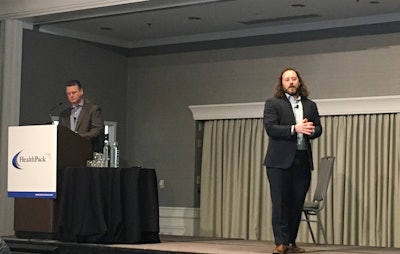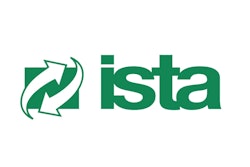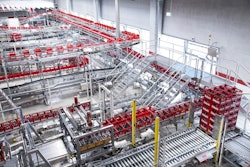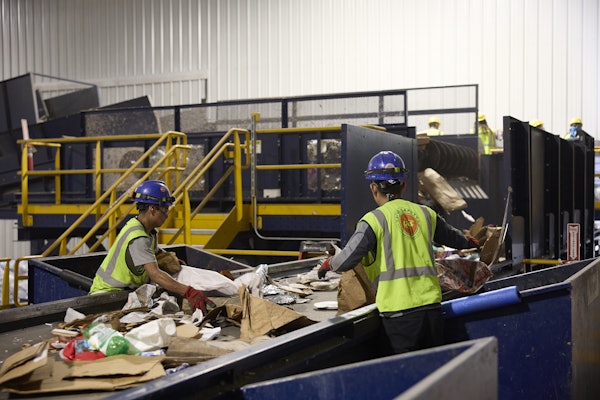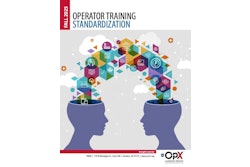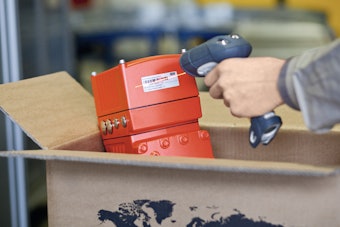Each day, approximately 14,000 tons of waste are generated in the U.S. at healthcare facilities, with 20 to 25% of this waste coming from plastic packaging and products.
Brand owners are increasingly looking at reuse and recycle-readiness of their products. In healthcare, flexible plastics pose a unique challenge for manufacturers, said Tristan Steichen, Senior Consultantat the Antea Group,and Nicholas Packet, DuPont Packaging Engineer, at Healthpack 2019 in Portland, OR.
A big problem in the industry is the “ick factor” from a recycler perspective, as companies are worried that healthcare plastics are biohazardous. But Steichen noted that 85% of hospital waste is actually non-hazardous, meaning free from patient contact and contamination. Waste is heated during the recycling process, so the concern is based on worker safety and exposure, as well as questions about who will buy the recycled material. “We have to deal with that perception,” he said.
Flexible packaging recycling project
Recently, a ground-breaking assessment took place with the Healthcare Plastics Recycling Council (HPRC), three healthcare operating rooms, Erema Plastic Recycling Systems and UMass Lowell to:
-
Determine viable strategies for recycling multi-material flexible plastic
-
Test whether commercially available compatibilizers improve blend properties (compatibilizers areadditives that help recyclers improve yields of mixed-materials)
-
Identify potential end market applications for the recycled product
The assessment involved material collection from the Cleveland Clinic, Dartmouth-Hitchcock Medical Center and Lehigh Valley Health Network, followed by accumulation and sorting, pre-processing, processing and testing and application study.
Multi-materials
While some markets push for pure-material packaging to make recycling easier, this assessment specifically studied multi-material plastics. Very few of the flexible plastics in the study consisted of just one polymer or plastic, which presents a challenge for recyclers who want consistency and predictability in the waste stream.
Dedicated blue bags were given to each facility and training was conducted on which materials should go into the bags and which shouldn't. As devices were opened, packaging was placed into the bag, tied off and put in a corner to avoid devices or bio-contaminated materials going into the bag.
Materials were shipped to Casella sorting facility in New Hampshire and sorted by a team of UMass students trained for the project. Stream 1 was flexible materials (mainly LDPE and HDPE) and Stream 2 was flexible packaging and blue wrap (LDPE and HDPE and non-woven PP). The streams accounted for 811 pounds and 1,315 pounds, respectively.
The material moved from Erema’s conveyor to a cutter and compactor, then to filtration, degassing and, in essence, a large extruder, after which the material was cut into pellets. The material reaches a temperature of approximately 220°C, enough to kill bacteria but not melt polyester.
“The Erema equipment is probably more state-of-the-art than other recyclers. They can remove contaminants as well as gas inclusions that make the final product not as consistent,” said Packet. It took approximately an hour to run each stream. Streams were tested with two different types of compatibilizers at four different loading percentages.
The highly sensitive metal detector caught some tiny metalized film suture packs, which would stop the conveyor. Sometimes they weren’t able to get the packs out and had to push them through.
Technical conclusions
-
Both compatibilizers they tested showed little or no effect on Stream 1, which behaved more like a polyethylene.
-
Compatibilizer 1 (D1052) was shown to greatly improve elongation properties in Stream 2, while other properties remained the same. Stream 2 behaved more like polypropylene.
-
Compatibilizer 2 (RETAIN 3000TM) had little effect on the properties of Stream 2
Key learnings: positives
-
The logistics of collection was also important beyond compatibilizer testing. Dartmouth-Hitchcock had an impressive collection and sorting technique, with buyers for different materials. Though it required a lot of education and diligence, effective sorting processes exist.
-
Pre-processing technology fared well at removing non-conforming materials, with pellet quality and consistency that exceeded expectations.
-
Testing conducted suggests there are potential applications for the recycled materials, and that the multi-materials don’t necessarily pose recycling challenges with the right processing and equipment.
Key learnings: challenges
-
The sorting process is labor-intensive. “We had to touch the material three to four times to remove nonconforming materials, so there’s definitely a lot of opportunity there. We learned a lot from the folks at Erema,” said Packet.
-
Contamination remains an occupational concern for pre-processing facilities dealing with healthcare waste.
-
Another concern is consistency. For creating a market and delivering to buyers, the streams need material consistency. Assuming the physical properties can be consistent, the industry will still need to deliver on volume and supply chain expectations. In terms of volume, the healthcare waste material is dispersed among the population, so that remains a challenge. Packet and Steichen mentioned combining waste streams with other waste streams that are similar, including food and beverage and high-quality industrial plastics. Any buyer of the material is going to want a guarantee of volume and consistency.
-
Companies can help hospitals handle materials by labeling what is in the package or explaining where it should or shouldn’t go. Sustainability directors for healthcare facilities have a tough job and they’re under great financial constraints. But another part of recycling is educating the recycler on how to handle materials.
-
Do manufacturers have a duty to label materials as “recycled from medical waste”? It may depend on the assurance that there is no contamination.
Questions for packaging engineers
-
How are customers disposing of your packaging? What is the waste management system like?
-
Is the package’s recyclability thought about in the development process? If not, what might change that? How could recycle-readiness bring value to the device?
-
Are your operations generating materials that can supplement the healthcare plastics recycling stream?
-
Do you have applications in your organization that can use second-life materials?
While the study results are promising, hospitals in Europe continue to strive for solutions that reduce the use of plastic from the outset. Susanne Backer, Project Leader for Circular Economy at Aarhus University Hospital in Denmark, says, “We follow all the experiments with chemical or thermic recirculation of hopeless plastic packaging, but do still prefer a longer-term strategy solving the problems by packaging re-design. Chemical fixes may come with unknown side-effects.”
